
How To Change Your Email Software In 2025 [Evaluation Process]
If you find yourself sending the same generic emails to your audience without tailoring messages for specific segments, or if it’s difficult to measure the return of your campaigns, it’s clear: your current tool may not be scaling with your business.
While changing your email software may seem like a daunting task, it’s necessary to have the right tool if you want to thrive, especially when you invest a small fortune in your marketing stack.
So, how do you find out if your software is still meeting your business needs? And what should you be looking for in a potential new tool?
In this guide, we’ll walk you through the process of evaluating your email service, from the features to the pricing, and more.
How to Evaluate Your Email Software
Here you’ll find our easy step-by-step evaluation process to see if it’s time to change your email tool:
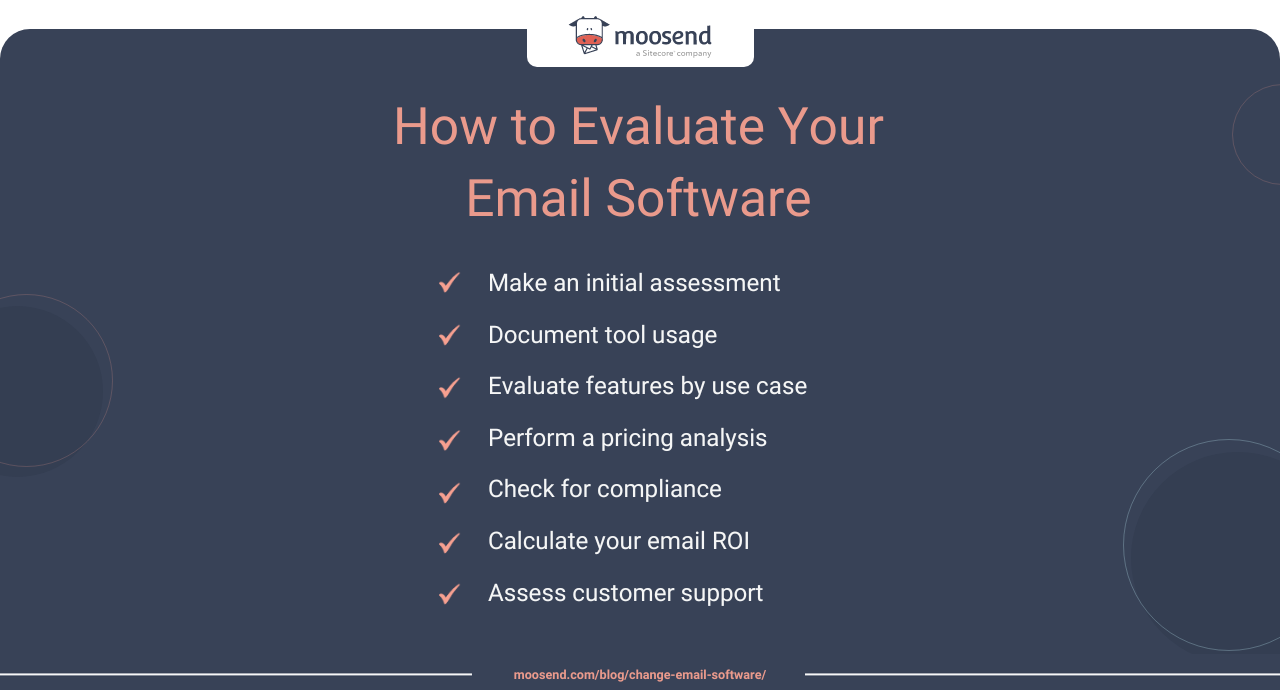
Let’s see more details about each step below.
1. Make an Initial Assessment
Every great evaluation of your marketing stack begins by clearly understanding why you initially chose your tool. Was it affordability or a specific feature that no other service offered at the time?
After you take that down, you need to think about your current business needs and how your platform assists your email marketing efforts.
Here are some questions to ask yourself:
- Does the software support your current workflow efficiently?
- Are you able to monitor KPIs, track customer interactions, or analyze marketing campaigns?
- Is the software cost-effective for your current business size and budget?
- Does the tool scale with your business?
- Is the software user-friendly for your team?
- How responsive and helpful is customer support?
- Are there any critical features missing that your business needs?
- How does the software integrate with other tools you use?
After you answer the above questions, you’ll have made an initial assessment of your software. However, this is just the tip of the iceberg.
2. Document Your Tool’s Current Usage
Finding how often and in what ways your email software is used by the people in your organization will give you a clear idea of its effectiveness.
To determine this, you should start by identifying the people and departments who use the tool and then evaluate the different use cases.
Identify users, teams, and departments
Let’s start with the most important question: who uses the email software in question?
First, email software can serve various functions, including marketing, sales, customer support, and internal communications, making it a versatile tool across different departments.
By listing all teams and individuals using it you’ll manage to reach out to them and collect feedback more easily.
For instance, if the marketing department is the primary user of the email tool, it’s essential to engage directly with those who interact with the software daily. Ask about the user experience and operational efficiency with questions like “How user-friendly do you find the software?” or “How much time does it take to create and launch a single campaign?”
Moreover, it’s important to gather feedback from numerous users across different departments to ensure a more objective evaluation and avoid any biased opinions.
Determine usage frequency
Apart from finding out who uses the software, you also need to see how often they use it. Ask yourself, is it worth giving a substantial amount of money for software your team uses only once a month?
Here, start by examining usage frequency, grouping your email marketing tool’s users into the following categories:
- Daily users: Identify individuals or departments that use the email software daily. For instance, customer support teams might rely on it for handling customer inquiries every day.
- Weekly users: Determine if some users engage with the software weekly, possibly for newsletters or updates.
- Monthly users: Some tasks, such as reporting or sending out monthly newsletters, might only require monthly access to the email software.
- Ad hoc users: Find those who use the software sporadically, perhaps for specific campaigns or announcements.
After this process, you’ll be able to draw certain conclusions about your software.
For instance, if the majority consists of satisfied daily users, then the tool has great usability and usage frequency and you should focus on other criteria, such as the pricing.
Email marketing software pricing can range from $4 to $890 a month. We’ll see more about the email tool pricing later in our evaluation.
Now let’s look at the use cases.
Understand your email use cases
As your business grows, the ways you use email software may shift to accommodate new strategies, communication needs, and customer engagement trends and tactics.
If you chose a platform for one purpose but now use it for another, it’s crucial to check how well it serves your team and their needs.
Below, you’ll find some of the most common email tool use cases:
- Marketing campaigns: promotional emails, product announcements, and newsletters.
- Internal communications: company-wide announcements or team updates.
- Customer support: inquiry responses, follow-ups, and satisfaction surveys.
- Transactional emails: order confirmations, receipts, account notifications, and password resets.
Documenting who uses the email software, how often and in what ways, will help you see whether the tool fits your business needs. If not, it’s time to consider seeking alternatives that better meet your objectives.
But before you get there, let’s see more about the above use cases and how to assess the features of your platform.
3. Evaluate the Features by Use Case
At this point, you may have a clear idea of how your team uses your email software. Now, it’s time to see its capabilities and functionality yourself.
Structuring your evaluation around the above use cases will let you pinpoint exactly what features are necessary for your team’s success and where your current software may be falling short.
Marketing campaigns
If you use the email service provider to create and send marketing campaigns, then you need to check whether your tool has the following features and how well they perform:
- Email builder: Does your editor allow for easy customization and creation of visually appealing emails without any coding? Also, does it offer advanced elements, like countdown timers?
- List segmentation: Can you segment your audience based on detailed criteria like user behavior, demographics, and purchase history?
- Personalization: Can tailor messages to the individual preferences and actions of your subscribers?
- AI capabilities: Most ESPs have AI-powered tools to enhance the creation and segmentation process based on customer insights. Does your tool offer such features and, if yes, are they usable?
- A/B Testing: Can you set up tests for different email elements, such as subject lines, email copy and send times. What data does it offer?
- Reporting and analytics: Do you get in-depth insights into campaign performance, such as open rates, click-through rates, conversion rates, and return-on-investment (ROI)? How actionable is the data for conversion rate optimization (CRO)?
- List management: Is it easy to keep your lists clean and organized while ensuring compliance with email regulations?
- Marketing automation: Can you set up flexible email automation that trigger based on specific customer actions? How long does it take to set them up?
If a feature is missing, you can always seek app integrations. However, your ESP needs to be able to connect to them seamlessly to achieve the same level of functionality. In some cases, they may be outdated, or you may be asked to pay for them, which isn’t ideal.
Moosend’s email marketing platform will make the job easier, offering all the core and advanced features you need to create, automate, and send your campaigns. Plus, it has an array of free integrations to help you streamline your efforts.
Internal communications
When using your email software for internal communications, the focus shifts towards features that keep your lists organized and distribute your content to different departments.
Let’s see them:
- List management: Evaluate the software’s ability to organize and segment contacts based on departments, teams, or project groups.
- Template customization: Check the availability of professional email templates, such as updates, announcements, and newsletters to save time. Also, see if these templates are easily customizable to maintain brand consistency.
- Collaboration functionality: Does the tool have content collaboration functionality, allowing multiple team members to work on your internal comms emails?
- Scheduling and timezones: Examine the scheduling features, including its ability to deliver messages at optimal times, considering the timezones of your employees.
- Security and compliance: Review the security measures and privacy options the software offers to protect sensitive internal information. Ensure it complies with relevant regulations, to keep your data safe against breaches and unauthorized access.
Customer support
To see if your tool is idea for customer support scenarios, consider the following:
- Automated replies: Evaluate the customization options and responsiveness of automated replies to check if they provide relevant and timely replies to customers.
- CRM Integrations: Determine how seamlessly the email software integrates with your CRM system.
- Customer feedback collection: Does your email software support email survey creation? If not, are there any available integrations?
- Personalized customer interactions: Check its ability to personalize customer interactions using data from your CRM system and past interactions for a better customer experience.
Transactional emails
If you use your ESP to deliver transactional emails, such as order confirmations, you should assess these features:
- Advanced eCommerce functionality: Does the software have dedicated eCommerce tools? How easy is it to set up cart abandonment workflows for your store? Are they advanced enough to take advantage of customer data for a more personalized experience?
- Email deliverability rates: Monitor your software’s track record for deliverability, especially for time-sensitive messages like password resets. These rates are susceptible to change, so ensure you check them often.
- Check personalization capabilities: See if the software allows for personalized detail insertion, such as customer names.
- Test scalability: Simulate peak email volumes to test the software’s ability to handle spikes without drops in performance or speed.
Email deliverability is a vital metric indicating whether your messages reach the inbox or land into spam folders. High bounce rates will indicate poor delivery rates, so check your metrics regularly to draw more accurate conclusions about your tool.
Moreover, for unbiased insights, consider external studies like Email Tool Tester’s deliverability reports, which offer delivery rate comparisons between popular tools.
Here’s their recent data:
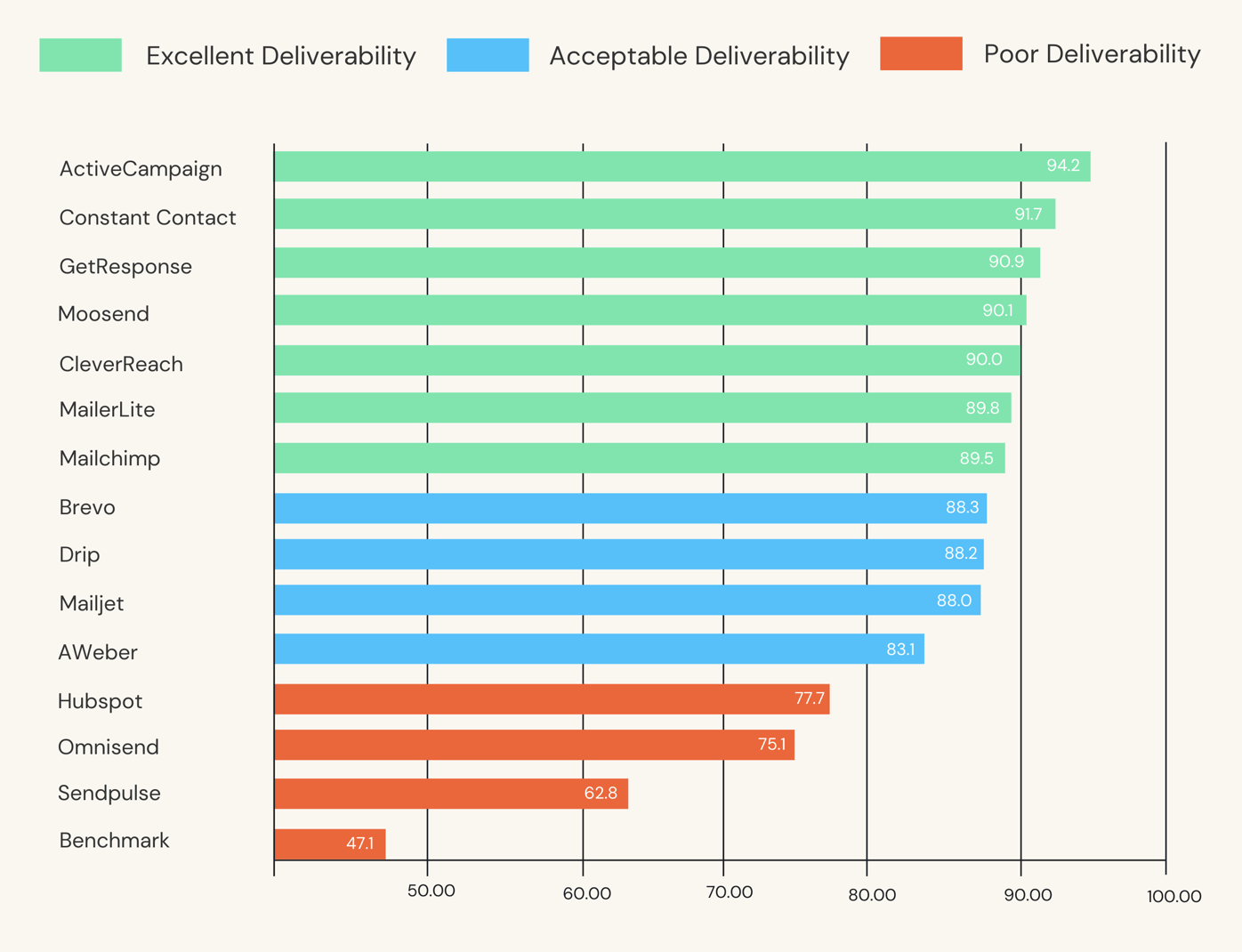
4. Perform a Pricing Analysis
With the feature evaluation done, it’s time to move on to the pricing evaluation of your software.
It’s quite possible that the paid plan for your email software has changed since your initial purchase. These changes can range from minor to more substantial, sometimes increasing costs by up to $10 a month or more.
Your evaluation should always match your current goals and budget. This will let you measure the software’s value in terms of usage frequency, subscriber base size, and campaign requirements against its cost.
Check your current paid plan
Start your analysis by gathering detailed information on all expenses associated with your email software, including:
- Subscription fees: Start with the base cost of your plan. If you pay monthly, multiply this amount by 12 to get the annual cost.
- Add-ons: Find the cost of any additional features or services that aren’t in your plan but are essential for your operations. This can include custom reporting, additional user accounts, etc.
- Excess emails/send limits: If your plan has a limit on the number of emails you can send or the number of subscribers you can have, estimate any overage fees based on past usage.
- Scaling costs: Estimate how your subscriber list is expected to grow over the year and how that will impact on your expenses. You can check the higher-tier plans and create a cost projection based on your data.
- Transactional emails: Some platforms charge you separately for their SMTP server. If that’s the case for you, add the monthly or yearly cost to your total.
- Third-party integrations: See if your email software requires additional payments for integrating with other tools or services (CRM systems, eCommerce platforms, plugins, etc.).
Moreover, if your current tool charges for duplicate contacts (as is the case with platforms like Mailchimp), you need to see how this affects your total costs. This practice can significantly increase expenses, especially if you have overlapping lists.
Pro tip: When you evaluate your pricing, always consider the features you’ll be using. Paying for more than you need will unnecessarily harm your budget. The same goes for getting a service that offers only basic features at a high price.
Calculate your email software cost
Let’s say you have a monthly subscription of $730, an annual premium feature add-on of $200, estimated overage fees of $50, and no additional costs. Your yearly cost would be:
Monthly subscription: $730 x 12 = $8,760
Premium add-ons: $200
Estimated overage fees: $50
Total yearly cost: $9,010
By calculating your email software expenses you can determine the software’s cost-efficiency. If the cost is greater than the benefits, you should consider downgrading to a lower-tier plan.
However, this means that you’ll lose access to premium features. In that case, seeking more affordable alternatives may be your best solution.
Compare with popular alternatives
Now that you have calculated your yearly cost, how can you tell if you’re paying too much for your software?
The best way to find out is to compare it with other popular competitors for the same number of subscribers.
Let’s take Mailchimp, for example. For a list of 50k subscribers, users pay $450 a month for 600,000 emails/month (Standard plan).
If that’s your total (without any add-ons, overages, etc.), then you should compare this to Mailchimp’s best alternatives:
- Moosend: $315/mo. – unlimited emails
- Constant Contact: $460/mo. – 12x your number of contacts
- ActiveCampaign: $699/mo. – 10x contact email send limit
- AWeber: $402.99/mo. – unlimited emails
Placing pricing options side by side will allow you to draw averages. If you see that your pricing is higher, you can start considering another solution. We’ll see more about that later.
Popular email software pricing analysis:
To help you out, we analyzed the pricing of some of the most popular email marketing platforms in the market.
- Moosend pricing
- Mailchimp pricing
- Brevo pricing
- MailerLite pricing
- Constant Contact pricing
- Kit pricing
5. Check for Compliance
With data privacy concerns rising, you need to make sure your email platform complies with relevant data protection regulations. The ESP must not only respect user privacy but also protect data against unauthorized access and breaches.
Let’s see some of the most important compliances and standards you need to check for.
Regulatory compliance
Your email tool needs to be compliant with specific laws based on your customers’ location, such as:
- GDPR (General Data Protection Regulation): Ensures data protection for EU residents, requiring consent for data collection and providing users with the right to access and delete their information.
- CCPA (California Consumer Privacy Act): Grants California residents the right to know about the personal data collected on them.
- Other regional laws: Depending on your target audience’s location, other specific laws like Canada’s Anti-Spam Legislation (CASL) or Brazil’s General Data Protection Law (LGPD) may also apply.
You should be able to find your tool’s compliance on their website.
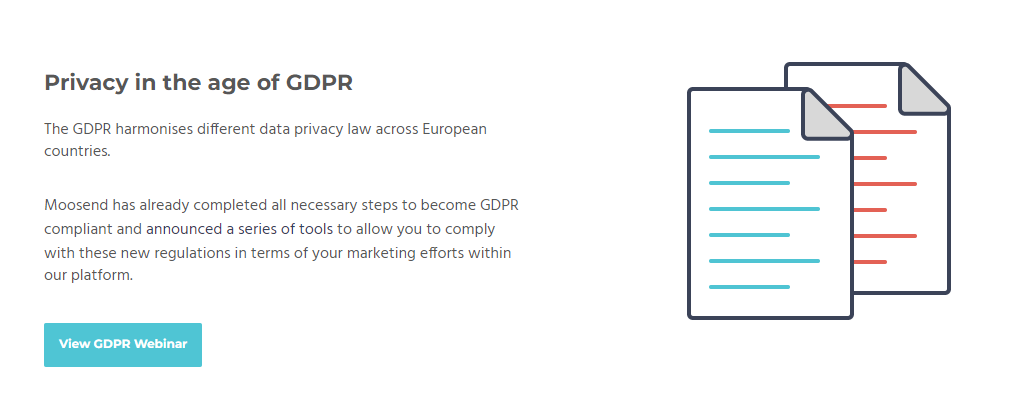
Standards and certifications
Check if your software complies with international standards and collaborates with certified organizations to ensure data safety.
- ISO/IEC 27001: An international standard on how to manage information security, offering a systematic and well-structured approach that ensures confidentiality, integrity, and availability of data.
- SOC 2 compliance: An audit process to confirm that service providers manage your data securely, safeguarding your organization’s interests and your clients’ privacy.
- PCI Security Standards: Sets the operational and technical standards for organizations handling credit card transactions to ensure the security of cardholder data. Compliance with PCI standards is essential for email platforms as they process, store, or transmit credit card information.
- M3AAWG (Messaging, Malware and Mobile Anti-Abuse Working Group): Membership or adherence to M3AAWG guidelines demonstrates a commitment to proactive measures against email fraud.
Your ESP should display all certifications on their website. Here’s an example from Moosend’s certification page:

Additional account security measures
Your email platform should have additional security measures in place to protect your account. This includes end-to-end data encryption, regular security audits to identify and remediate potential vulnerabilities, and secure data storage practices.
Additionally, features like two-factor authentication (2FA) for account access and the ability to quickly respond to and recover from security incidents are necessary.
6. Calculate Your Email ROI
Does your email software contribute to your growth?
To answer the question, you need to perform an email ROI analysis to see how much value your email software generates. Let’s see how you can do that before you get to the last stage of your decision-making process.
- Calculate your gain: Sum up all sales directly resulting from your email campaigns within a specific period. This can be tracked through conversion tracking tools or analytics platforms.
- Determine total costs: Collect all expenses related to your email marketing, including the subscription fees, costs for design and content creation, and any additional resources utilized for the campaigns.
When you have your gain and costs you can use the formula below to find your email ROI:
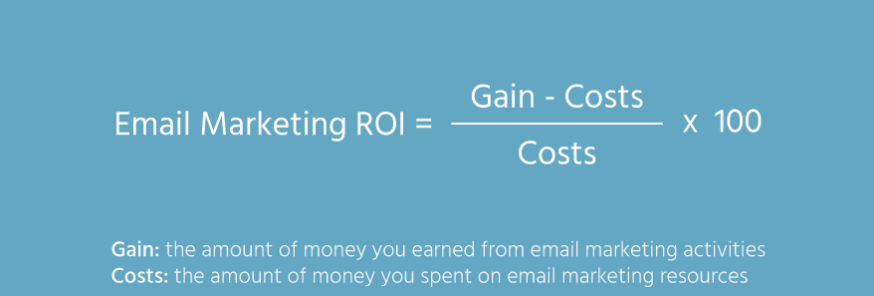
A great ROI should be anywhere between $38-42 for every $1 you invest in email marketing. So, the next question you need to ask yourself is whether your email tool helps you get those results through its features and delivery rates.
7. Assess Customer Support
Another aspect that you should review is the customer support offered. Many tools provide users with email, live chat, and phone support, along with knowledge base and tutorials.
Since live chat and email are the most frequently used channels, start by assessing the quality, availability, and responsiveness of the representatives. You can also ask for feedback from your team, including how fast they solved an issue and how helpful customer support has been so far.
Evaluating customer support will also help you find out what problems your team has encountered so far. If you spot recurring issues, you should investigate more thoroughly.
Speaking of issues, you should take some time to check your software’s historical uptime records and reliability metrics. A tool with numerous bugs and downtime can only harm your operations.
What Happens if You Decide to Change Your Tool?
If after your assessment you concluded that you need to change your email software, either due to its limited capabilities or the steep pricing, you can start exploring your options.
As mentioned above, searching for a great alternative will help you get back on track and solve your pain points. Here are a few simple steps to take:
- Conduct research on alternative email software options that could meet your needs better.
- Consider your use cases before you start evaluating them.
- Compare the features, pricing, support, and performance of these alternatives against your current solution.
- Use free trials or demos to test their usability before your commit.
- Take scalability into account to ensure that your new tool will serve not only your current needs but also your future goals and objectives.
To help you, below you will find resources of the popular tools out there with their best alternatives:
- Mailchimp
- HubSpot
- Constant Contact
- ActiveCampaign
- Omnisend
- Campaign Monitor
- Klaviyo
- GetResponse
- Brevo
- MailerLite
- AWeber
- Kit
For more, you can always visit the Moosend blog where you’ll find additional resources on tools and their competitors.
Pro tip: Look for a tool that offers scalability. Avoid providers that impose steep price jumps for small increases in list size or email volume, which can disrupt budget planning.
Helpful Resources
If you need more resources to make your final decision, you can read reviews and tool comparisons.
Here are some helpful email software reviews:
- Moosend review
- Mailchimp review
- Klaviyo review
- ActiveCampaign review
- MailerLite review
- Brevo review
- Constant Contact review
- Kit review
And here you can find some tool comparisons:
- Moosend vs Mailchimp
- Constant Contact vs Mailchimp
- ActiveCampaign vs Mailchimp
- Brevo vs Mailchimp
- Kit vs Mailchimp
Time to Change Your Email Software
After analyzing the key aspects, you can now decide whether to stick with your current email software, switch to a new one, or possibly negotiate better terms with your provider.
A cheap tool might seem cost-effective at first, but if it requires a lot of manual work, it could end up costing you more in time and effort. On the other hand, an advanced platform with lots of features might not be worth it if you’re only using a few of them. To avoid such pitfalls, creating a checklist of what you really need and what you don’t want is a smart move.
Also, don’t forget to try any free plans and trials as they’ll allow you to test the features yourself. For example, Moosend offers a 30-day free trial to let you and your team try everything before committing.
Whatever you choose, keep scalability and affordability in mind before you take the next step.
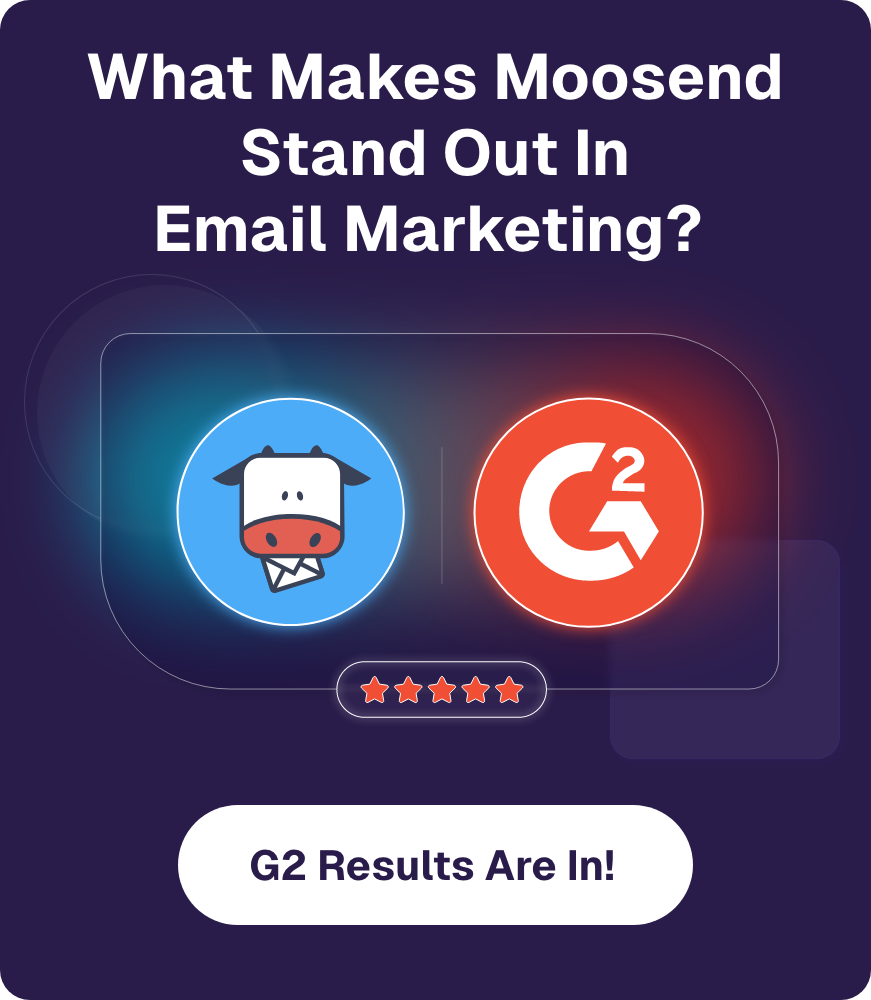



 Published by
Published by

